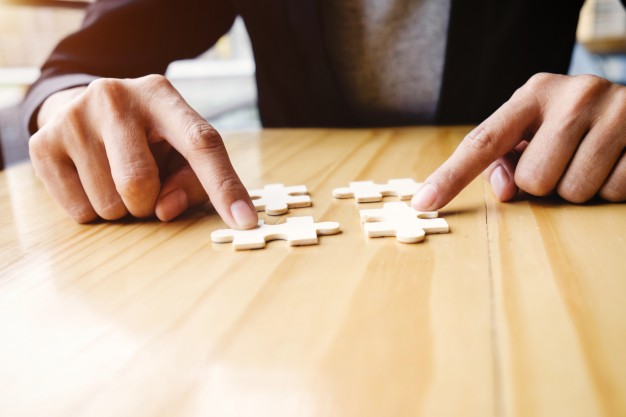Jigsaw

Comparative analysis of tools and techniques
Overview
Jigsaw is a cooperative learning strategy that encourages people to develop their own understanding and then share knowledge with the group as a whole. It is a powerful learning method that embeds lessons when participants teach peers in the report-back round. Working groups are each assigned a particular part of a problem, or puzzle piece, and the tools to develop in-depth knowledge of that specific component. The pieces are then put together using visual materials and facilitation techniques.
How to use it
- Facilitate peer-to-peer learning and encourage participation.
- Perform critical analysis and comparative thinking.
- Examine complex systems in manageable pieces.
- Learn new theory and relate contexts.
How to apply it
Setting:
An appropriate working space for all the groups to document key points.
Materials:
All the material for the various puzzle pieces, including any visual information that you would like participants to use in their report back to the group.
Time/Steps:
- Prepare a list of all the possible ‘pieces’ of the session’s subject (for example, institutions, steps in a process, or research methods).
- Collect sources of information for the working sessions, including visual presentations.
- Split the learners into the appropriate number of working groups to allow each team to examine their “piece” separately, using the resources or tools provided (such as brief articles, images or access to the internet).
- Provide reflection questions that will guide the participants through all the important learning aspects of the “piece”, including background information, context, actors and consequences.
- Provide access to the internet or other resourcesif the participants are not familiar with the methods in advance.
- Design a series of questions to guide the group reflection process. These should elicit information from each group about their piece of the puzzle, such as background information, opportunities and risks, relevance to a particular scenario, and whether its selection would achieve the desired outcomes.
- Instruct the groups to identify someone to take notes, and someone to keep time. This will ensure that the activity is recorded and that all questions are covered within the time limit.
- 30 mins: Initial reflection. Then close the discussion for a report back.
- 10 mins per debrief: The report back between groups provides information to all the participants about the key recommendations for all of the methods examined. Instruct each group to report back their observations and key reflections, clearly and comprehensively.
- 15-20 mins final discussion: to ensure that the pros and cons of each method are addressed and that the group is confident enough to make future decisions.
How to adapt it
After the initial round of reflection, create new groups composed of one representative of each original group to bring all the pieces together to form the full puzzle. The discussion then proceeds as each representative explains their results.
Case study
Title:
Engaging stakeholders in evaluation
Activity:
Evaluation manager certification program
Contact:
G.Mercier@itcilo.org (SDG)
Description:
A project context that required evaluation was presented at the beginning of the session. The participants were given a one page summary of the project and were asked to collectively identify the key stakeholders in the project. Five stakeholders were identified (e.g. unions, government, ILO, …). Afterwards the participants were divided in five groups: each group representing one of the identified stakeholders (one group was the government, one groups was the ILO, one group represented the unions, …). The participants had to come up with 20 – 25 questions about the presented project based on the standard criteria for project evaluation. The questions had to be formulated from the perspective of the stakeholder they represented. After formulating the questions, the jigsaw was applied. New groups were formed with each group containing persons that previously had belonged to different stakeholder groups. The newly created groups had to contain the five possible stakeholders (a person who previously was in the group representing the unions, a person who previously was in the group representing the government …). The new groups had to come up with only 10 questions based on the 20 – 25 questions each member of the group brought with him/her from the previous groups (so in total they had more or less 125 questions to choose from). They had to select the 10 questions that matched the best with the interests of all the different stakeholders.
Tips
- Instruct the working groups to use visual debriefing resources. These may include pictures provided with the initial article, diagrams created on flipcharts, or key words used as speaking notes.
- A double debrief can be effective: in a second debrief, an expert is present to make any corrections or additions to the discussion.
Resources
- Brief video describing the jigsaw method with model maps: http://tinyurl.com/2wynny7
- How it is used with school children: http://www.jigsaw.org/





